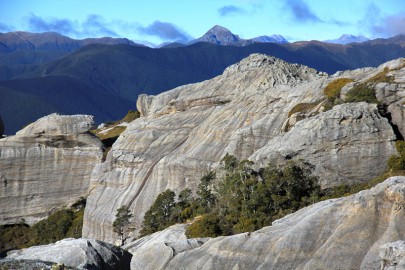Cliffs, scarps and tors of quartzose rocks
In this section
-
Inland & alpine
- Basic cliffs, scarps and tors
- Boulderfields of acidic rocks (non-volcanic)
- Boulderfields of calcareous rocks
- Boulderfields of quartzose rocks
- Braided riverbeds
- Calcareous cliffs, scarps and tors
- Calcareous screes
- Cliffs, scarps and tors of acidic rocks
- Cliffs, scarps and tors of quartzose rocks
- Cloud forests
- Frost hollows
- Granitic gravel fields
- Granitic sand plains
- Inland outwash gravels
- Inland saline (salt pans)
- Inland sand dunes
- Limestone erosion pavements
- Moraines
- Old tephra (>500 years) plains (= frost flats)
- Recent lava flows
- Sandstone erosion pavements
- Screes of acidic rocks
- Strongly leached terraces and plains
- Ultrabasic boulderfields
- Ultrabasic cliffs, scarps and tors
- Ultrabasic hills
- Ultrabasic screes
- Volcanic boulderfields
- Volcanic debris flows or lahars
- Volcanic dunes
- Young tephra plains and hillslopes

Sandstone cliffs near Garibaldi Ridge, north-west Nelson (Rowan Buxton)
The term “quartzose rocks” applies to sedimentary rocks comprised primarily of quartz particles. They are very acidic (low pH) and mostly in areas of high rainfall, making them very infertile. Cliffs and scarps are steep faces on hill slopes and ridges and dropping to valleys, whereas tors are steep-sided upstanding outcrops sitting atop other landforms such as ridges. They provide habitats ranging from bare rock holding little moisture in highly exposed situations and colonised only by mosses and lichens, to deeper moist soils in heavily shaded and sheltered habitats supporting hebes, epacrids and other heath-like shrubs and flax. Native species that have been lost from neighbouring habitats because of animal browse find refuge on cliffs, scarps and tors.
Notable flora and fauna
Compared with on more fertile rock types, the number of species on these landforms is relatively few and no threatened plants are recorded. Landscapes on the West Coast with these steep features are habitats for several endangered snails (Powelliphanta spp.) but these animals are largely confined to gentler slopes. Otherwise, threatened and rare fauna are unknown.
Threat status
Not threatened (Holdaway et al. 2012)
Threats
Communities on cliffs scarps and tors of quartzose rocks are vulnerable to competition from exotic weeds. However, as they are generally very infertile, the number of species is limited. Rock climbing can have an impact on some cliffs and outcrops. Browsing impacts from goats, deer, possums and rodents are likely to be present in some sites. Cliffs and outcrops are largely naturally sparsely vegetated and erosion would have always been part of their landscape dynamics.
Where do they occur?
Quartzose rocks are common in western Nelson and the West Coast in association with other sediments including coal measures, i.e. Garibaldi Ridge and Mt Rochfort.
Further reading
Wardle P. 1991. Vegetation of New Zealand. Cambridge University Press. Pp. 375-396.
Williams PA 1993. The subalpine and alpine vegetation on the Central Sedimentary Belt of Paleozoic rocks in north-west Nelson, New Zealand. New Zealand Journal of Botany 31: 65-90.


